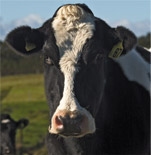Guidelines for cleaner water

How can farmers help reduce faecal contamination of freshwaters? We have been working on a collaborative research programme for the Ministry of Agriculture and Forestry, looking at how faecal microbes get from farm animals to waterways.
Grazing livestock are a major source of faecal contamination, which can pose a health risk to swimmers and restrict shellfish aquaculture. Furthermore, recent studies have provided evidence to link the productivity of cattle with the microbial quality of their drinking water.
Broadly, NIWA scientists and our collaborators have identified these ‘best management practices’ to help farmers reduce contamination:
- build bridges over streams that intersect farm raceways
- establish riparian buffer strips
- exclude stock from ephemeral streams, wetlands, and seeps
- adopt optimal methods for the irrigation of both dairy shed effluent and water on to land
- avoid, or reduce, grazing and irrigation upon poorly drained soils
- use Advanced Pond Systems as an alternative to land application of effluent (see following page)
The Ministry is due to publish detailed best management practice guidelines arising from this work shortly. We worked on the project with AgResearch, ESR, Landcare Research, Massey University, and the research company Thinking Animals.
